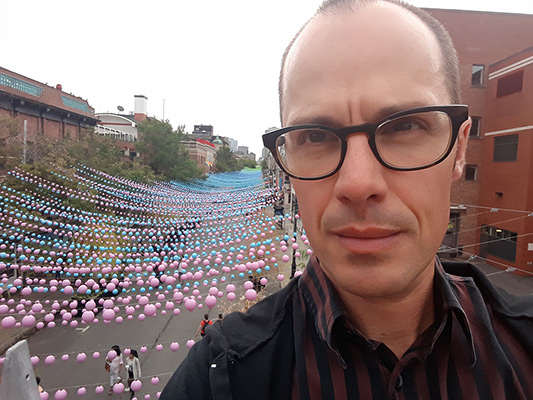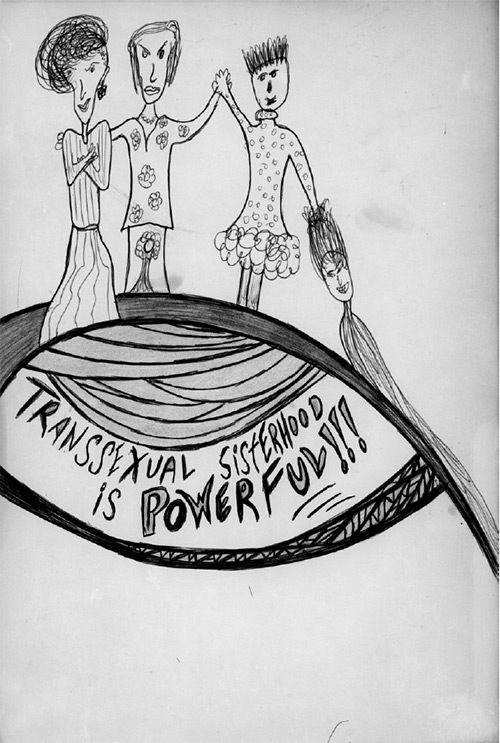By James Gunn
Artist, activist, and sex-worker Mirha-Soleil Ross is able to speak with an insider’s understanding based in her lived experiences. But these experiences also set her apart from many within the queer community. Mirha-Soleil comes from a working class background and an impoverished childhood in Quebec. She has argued that the role of class— as a defining category within the queer community—is all too often glossed over. This lack of acknowledgement by queer community organizers and service providers results in lower class individuals, such as trans sex workers, being excluded or underserved. It is with great pride we announce Mirha-Soleil’s inclusion in the National Portrait Collection. Archivist and librarian Aaron Cain, who nominated Mirha-Soleil for this honour, speaks to her contributions.

Aaron, let’s begin with a description of your history, areas of interest, and expertise.
I am dedicated to information; preserving, promoting and making it accessible to as many people as possible. I am particularly dedicated to information created by underrepresented groups such as the LGBTQ2+ and Indigenous communities.
Since I moved to Toronto in 1989 under the guise of attending university, but primarily to escape my small home town, I have been involved in Toronto’s queer and arts communities. My role has seldom been that of a leader or the ‘public face’ of much of anything, but I have been watching, participating in and analyzing events and movements with the eye of an information specialist. This has helped me in my more recent work as an archivist. I can frequently connect people and events to help recreate our community’s history.
About three years ago, I joined a group at the ArQuives working to process the large donation of material that became the Mirha-Soleil Fonds. Because so much of her Toronto life and mine overlapped, the experience of working on her fonds was deeply personal and, at times, emotional for me. Mirha and I had friends in common, I had attended her performances, and we also shared the pressure and dangers or being a trans people.
Mirha moved back to Quebec in the mid 2000s and I became much less socially active in the queer community around the same time. Processing her fonds reminded me of the importance of her work and the enduring relevance of it. When I heard that the ArQuives was accepting nominations for inductees to the National Portrait Collection, I did not need much encouragement to begin her file.
When did you first become aware of Mirha-Soleil Ross, her art and activism?
I am trans and this year marks 20 years since I began my transition. My transition to ‘male’ was made possible largely because of Mirha-Soleil Ross. Meeting her in the mid ‘90s assured me that there were more options for trans people than what I had grown up seeing on day time television; the pathetic, lovelorn trans man or hyper feminine, devious trans woman.
Before meeting Mirha-Soleil, I was vaguely aware of her as a fast-talking dynamo of a woman from Quebec who was openly trans, vehemently vegan and who loved punk rock. Those characteristics alone made me take note of her but when I was introduced to her by a mutual friend at a concert at Lee’s Palace, I quickly realized that she would play an even more significant role in my life.
Mirha-Soleil was a revelation to me. She presented as undeniably female but without an overly feminine affect. I knew I was not comfortable with strict and polar opposite gender roles but was struggling with why I was still not happy being merely a non-feminine female. Mirha’s gender presentation helped me realize that my desire to transition to male and simultaneous desire to not follow male gender norms was not a contradiction.
This is one aspect where Mirha-Soleil bucked tradition. Her art, activism, teachings, pretty well every aspect of her public life, had a similar aspect of rebellion.
What is the most important message surrounding stigma in sex work you would like to shed light on for the LGBTQ2+ communities?
Mirha-Soleil identified as a sex-worker. She was very active in advocating for the rights of sex-workers, in particular trans feminine ones. But, similar to what I describe above, she took a less popular stance in her advocacy. Mirha-Soleil refused to be seen or have her community portrayed as victims who needed to be rehabilitated. She was adamant that sex-workers should have support services, just as any other member of society does, but not with the end goal of converting people out of sex-work. As her autobiographical play states, she was an “unrepentant whore”! Mirha demanded acknowledgement and respect for herself and all the others working in the industry.
Meal Trans, the program which she and Tina Strang began, provided services for sex-workers, particularly low income trans-feminine ones. Meals were provided, support was given and friendships were made. But equally important, the program was run out of the 519 Community Centre placing it in the physical as well as social centre of Toronto’s LGBTQ2+ community. Mirha demanded her equal place as a trans woman, sex-worker and as a low income person. These three characteristics had historically caused a wide separation within the community but Mirha refused to be pushed out or stigmatized.
Performance art can be a politically powerful tool. Can you share an example of Mirha-Soleil’s work that personally motivated you?
So much of Mirha-Soleil’s public life and activism could fall into the category of performance art that I have a hard time picking an example. My choice is; her 2001 performance as the Grand Marshall of the Toronto Pride March. For the occasion, she used the honorary platform not for her own gain but to highlight an issue she had dedicated much of her time to: animal welfare. Mirha-Soleil and a group of her friends lead the march wearing coyote masks and carrying placards with statistics detailing the number of animals removed from research labs and other similar facilities.
I had been a lazy half vegan for some time but Mirha’s influence, as the Grand Marshall but also her weekly Animal Voices radio show, helped me be conscious of the effect my lifestyle has on non-human animals and underscored the importance of being vegan.
How do you hope Mirha-Soleil’s inclusion in the National Portrait Collection will foster communication across community lines?
There is very little of Mirha-Soleil’s work that was not political. So much so that I believe few people who experienced her work, in any of its forms, felt ambivalence toward it. In February 2019, Morgan M. Page published an article entitled, “The forgotten legacy of trans artist and activist Mirha-Soleil Ross” (https://www.dazeddigital.com/art-photography/article/43093/1/mirha-soleil-ross-morgan-m-page-chelsea-manning-trans-art).
Although it breaks my heart to think that Mirha’s work may be forgotten, I believe Morgan’s assessment may be accurate. I attribute this community amnesia in large part to Mirha’s politics. Morgan writes, “Throughout her tenure as an activist and artist, Ross consistently pushed at the limits of the LGBTQ+ movement, prodding it to consider its relation to sex workers, indigenous communities and the very fate of the planet itself.” I believe it may be easier for our community to shelve the issues raised by Mirha and to consider the work as having been addressed therefore no longer relevant versus continuing to evolve in the direction Mirha encouraged. There is still work to be done. While we now have prominent trans feminine role models, there is still a pronounced stigma around sex work and the class divide among the LGBTQ2+ community is still largely ignored.
Now that her fonds are processed and available for researchers to consult at the ArQuives, I hope her induction into the National Portrait Collection will reignite some of the very important discussions she initiated.




